Struggling with slow and cumbersome business processes? It’s time to accelerate your operation. Discover effective tactics to improve process efficiency within these pages, from tech upgrades to team training. Begin your journey toward a streamlined, cost-efficient workflow right now by exploring our seven focused strategies designed to transform your business processes into models of efficiency without the fluff.
Key Takeaways
- Effective process efficiency isn’t just about the workflow itself; factors like team skills, communication, and quality management systems play substantial roles in achieving an efficiency rate over 100%, which is considered exceptional.
- Identifying inefficiencies demands a combined approach of process mapping techniques, such as BPMN diagrams and swimlane diagrams, employee feedback, and data analysis, to accurately pinpoint areas needing improvement.
- Improving process efficiency requires a strategic implementation of different methods, including automation of repetitive tasks, enhancing communication and collaboration, addressing bottlenecks, and investing in employee training, while leveraging technology.
Article Outline
Understanding Process Efficiency
Business process efficiency can be seen as the measuring stick for your business success. It gauges the amount of work or effort needed to meet your objectives. The higher the percentage of process efficiency, the more value is being added to your operations through an efficient process, leading to an efficient business process.
In fact, any process with an efficiency percentage over 100% is considered a gem, indicating that it’s working wonders for your business by delivering higher efficiency.
Factors Affecting Process Efficiency
It’s easy to assume that process efficiency is solely reliant on the processes themselves. But like a jigsaw puzzle, there are several pieces that fit together to paint the full picture. One of these critical pieces is your team.
The efficiency of your processes is largely dependent on the skills of your employees. Unskilled employees can significantly hinder process efficiency, causing a ripple effect on your business productivity.
Another crucial factor that can steer the wheel of process efficiency is communication. Effective communication across your organization ensures that both management and employees understand their roles and responsibilities, leading to better efficiency.
This is where the implementation of a quality management system comes into play. It fosters a collaborative culture, reduces fear of mistakes, and increases commitment to your organization’s success, laying a solid foundation for efficient processes.
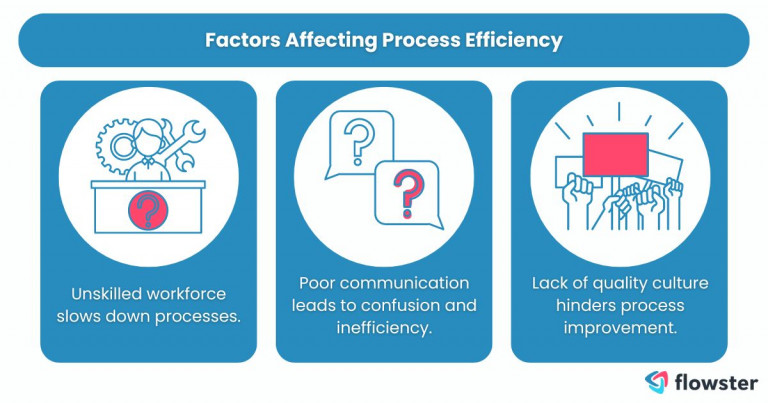
Benefits of Efficient Processes
Now that we’ve established what process efficiency is and the factors that influence it, let’s delve into the benefits that efficient processes have to offer. One of the most notable benefits is cost savings.
By identifying and eliminating inefficiencies, your organization can optimize operations and improve the bottom line. This not only increases your profitability but also puts you on a path to sustainable growth.
But the benefits of efficient processes don’t stop there. They extend to reducing errors, increasing the overall quality of output, and enabling faster customer service. By streamlining processes, your organization can minimize waste, leading to higher customer satisfaction and improved productivity.
And let’s not forget the positive impact on employee satisfaction. By reducing tedious, repetitive tasks, your staff can engage in more meaningful work, boosting morale and fostering a conducive work environment. Implementing more efficient processes can further enhance these benefits.
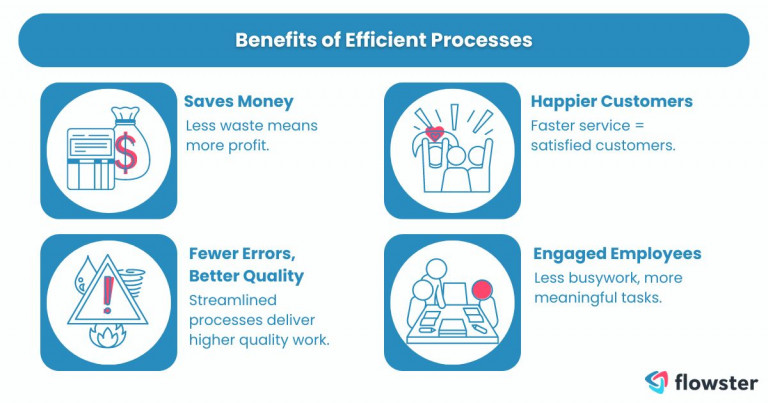
Identifying Inefficiencies in Your Business Processes
So, you’re sold on the idea of process efficiency and ready to jump on board. But before you can improve your processes, you need to identify where the inefficiencies lie. This is akin to a doctor diagnosing a patient’s illness before prescribing treatment. But how exactly can you pinpoint these inefficiencies? Well, believe it or not, the answers lie within your business.
There are several techniques at your disposal to help you visually identify process inefficiencies, with one of the most effective being process mapping techniques like BPMN diagrams, flowcharts, and swimlane diagrams. These techniques provide a visual representation of your processes, making it easier to spot areas that need improvement.
But process mapping techniques aren’t the only tools in your arsenal. Feedback from employees directly involved with the processes and leaders engaged with different teams can provide invaluable insights into existing pain points.
Work piles, identified bottlenecks, and complaints are measurable indicators that can guide your analysis of performance to spot inefficiencies. By combining process mapping, employee feedback, and performance monitoring, you can effectively target and identify inefficiencies within your business processes.
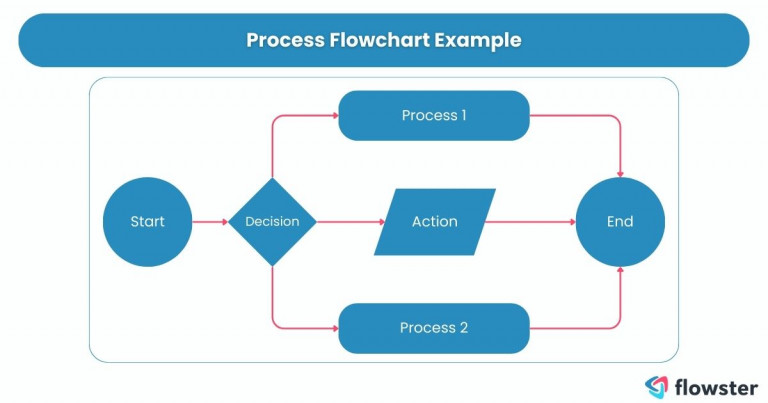
Process Mapping Techniques
Process mapping techniques are like navigational aids, guiding you to hidden treasures of efficiency within your business. Some common techniques used in process mapping include:
- Flowcharts
- Swimlane diagrams
- Value stream maps
- BPMN diagrams
These tools help visualize and document the flow of work within an organization. These techniques provide a visual representation of your processes, making it easier to spot inefficiencies.
In addition to these common techniques, there are other tools at your disposal, such as business process modeling notation. For example, Data Flow Diagrams, also known as Yourdon’s technique, illustrate how information flows from one place to another, linking processes through data stores and the external environment.
On the other hand, SIPOC diagrams provide a high-level process map that visually represents a process by breaking it down into suppliers, input, process, output, and customers without going into excessive detail. By mapping processes using various techniques, you can identify potential bottlenecks and streamline your operations.
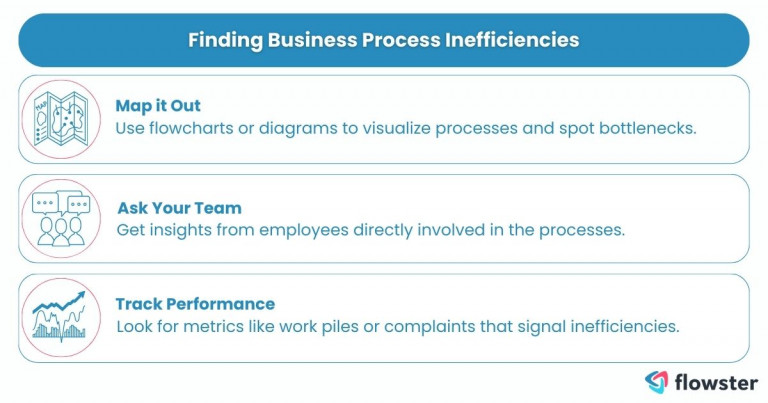
Analyzing Performance Data
Analyzing performance data is like peering through a telescope into the cosmos of your business processes. It provides a clear view of your process landscape, enabling you to spot inefficiencies that might otherwise go unnoticed.
But to ensure that your observations are accurate, it’s essential to conduct data cleansing and preprocessing. This involves rectifying errors, handling missing values, and eliminating outliers.
Once your data is clean and accurate, you can leverage various analytical techniques such as regression analysis, cluster analysis, and time series analysis. These techniques can uncover relationships within data, segment data for focused improvements, and forecast future trends.
Moreover, data visualization with dashboards simplifies the interpretation of complex data sets, while testing analysis with historical or simulated data validates the reliability of the performance metrics. By incorporating analytics tools and software, you can enhance the accuracy and efficiency of monitoring and analyzing performance data.
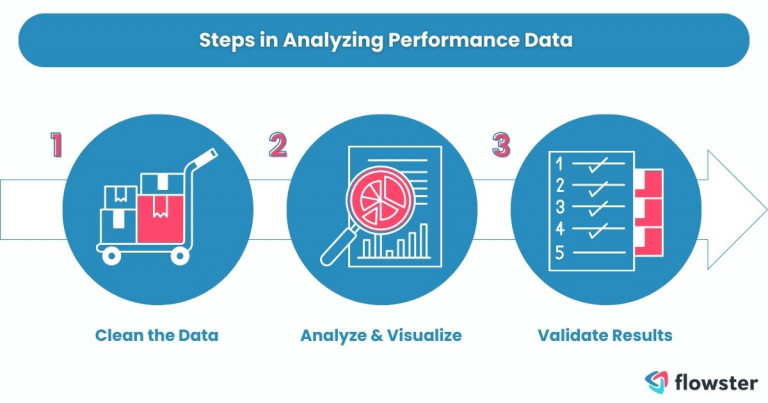
Implementing Strategies to Improve Process Efficiency
Now that you’ve identified inefficiencies in your business processes, it’s time to roll up your sleeves and start implementing strategies to improve process efficiency. But remember, Rome wasn’t built in a day. The same applies to improving process efficiency. It requires a carefully orchestrated approach, involving training and awareness-building for employees, and an integrated approach combining various strategies.
One strategy that has proven to be highly effective is the involvement of team members in the improvement process. Discussing issues and collaboratively creating a detailed action plan based on shared findings can lead to more effective solutions. In addition, advanced workflow automation tools like Cflow can simplify complex workflows, making your processes more efficient.
But the power of technology doesn’t stop at automation. Digital Adoption Platforms (DAPs) can guide users through tasks and offer customized interactive guides and tutorials. By consolidating processes into a single system, small to medium-sized businesses can leverage tools like Cflow to streamline their operations.
Transform Your Business with Flowster's AI-Driven Automation
Automating Repetitive Tasks
Imagine a world where you no longer have to perform monotonous tasks. A world where you can focus on tasks that require your expertise and leave the repetitive tasks to automation software. That’s the power of automating repetitive tasks. It streamlines your workflows, resulting in:
- Enhanced process efficiency
- Increased productivity
- Improved accuracy
- Reduced human error
- Time and cost savings
- Higher profit margins
Automating repetitive tasks through process automation doesn’t just boost your process efficiency; it also improves the overall productivity of your team.
Automation software can perform multiple tasks simultaneously, far exceeding human capacity for multitasking. In addition, the standardization inherent in automation results in more consistent outcomes, elevating your quality control measures.
Some benefits of automating repetitive tasks include:
- Boosting process efficiency
- Increasing overall productivity
- Performing multiple tasks simultaneously
- Exceeding human capacity for multitasking
- Standardizing processes for more consistent outcomes
- Improving quality control measures
As your business grows, the scalability of automation software becomes a key advantage, allowing for larger workloads without proportional increases in costs.
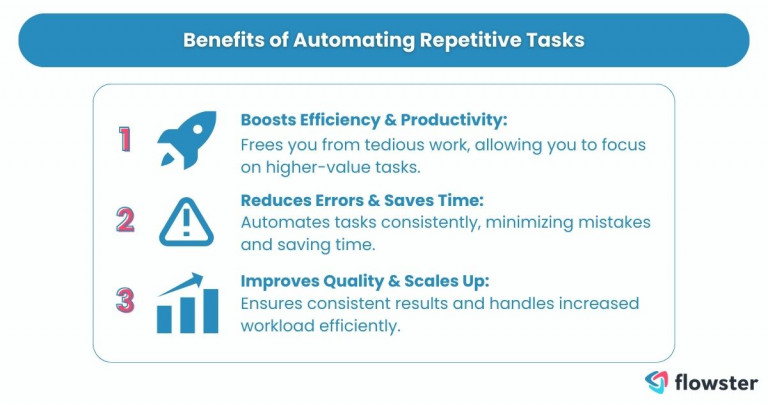
Enhancing Communication and Collaboration
In the quest to improve process efficiency, the importance of communication and collaboration cannot be overstated. It’s like the glue holding the pieces of your process efficiency puzzle together. By recognizing individual communication styles, such as:
- dominant
- influencer
- conscientious
- steady
Team leaders, especially when hiring project managers, can manage their teams effectively.
Team communication can be significantly improved by using the following tools:
- Messaging apps
- File sharing
- Video conferencing
- Document editing
- Project management software
In addition, encouraging bottom-up communication and striving for transparency within the team can create an inclusive environment and reduce miscommunication risks. Regular team meetings, brainstorming sessions, and consistent feedback can enhance engagement and conflict resolution, paving the way for better process efficiency.
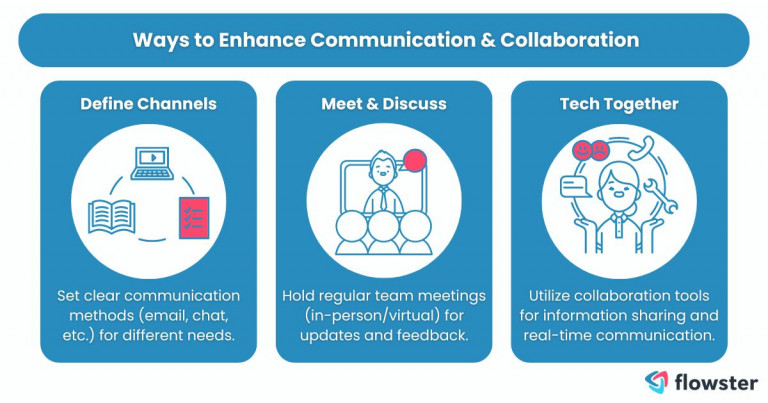
Eliminating Bottlenecks and Redundancies
Bottlenecks and redundancies in your business processes can be like roadblocks on your journey to process efficiency. They slow down your progress and can even cause you to take detours. But by analyzing your business process flow, you can identify these roadblocks and find ways to circumvent them.
Root cause analysis is an effective tool for understanding the factors that contribute to a bottleneck. By pinpointing these factors, you can develop effective solutions to eliminate bottlenecks and streamline your operations.
In addition, observing workflows and questioning the necessity of process steps can provide insights into potential bottlenecks. Streamlining can be achieved by simplifying complex processes and stripping away unnecessary tasks, thereby removing operational inefficiencies.
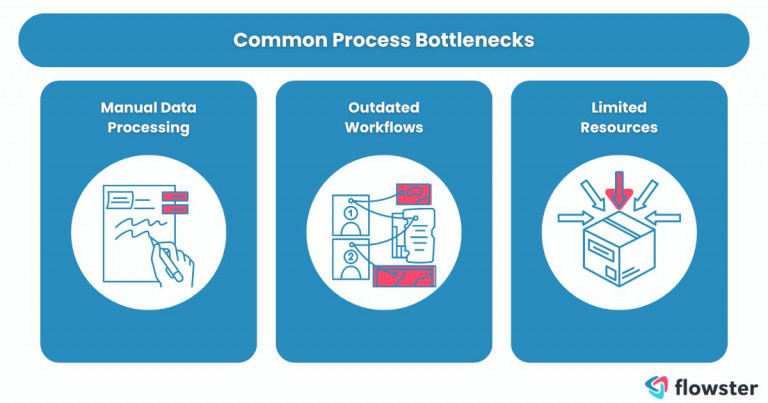
Setting Clear Goals and KPIs
In the world of business, goals and KPIs are like the North Star, guiding you towards your desired destination. They provide a clear path to follow and help you stay on track. But it’s not enough to simply set goals and KPIs; they need to be clear and aligned with your business objectives.
Establishing SMART (Specific, Measurable, Achievable, Relevant, and Time-bound) goals can ensure effective performance data analysis and set realistic expectations. On the other hand, KPIs need to be accurately defined to maintain validity and consistency across your organization.
By aligning your performance goals with your company’s strategy and continuously updating your metrics based on business needs, you can ensure sustained improvements and identify process bottlenecks.
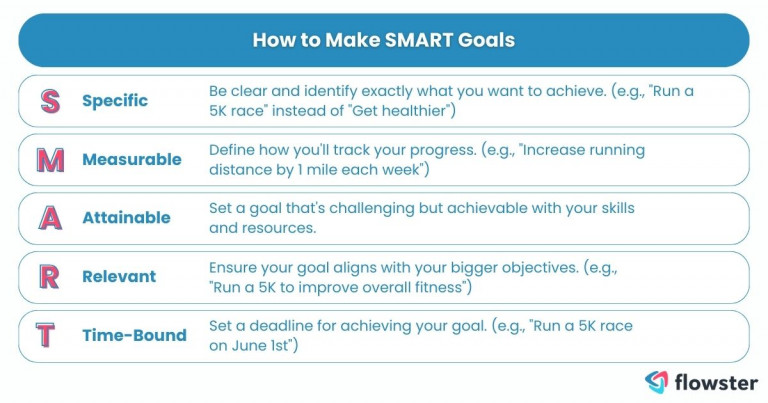
Investing in Employee Training and Development
Your employees are your greatest assets. By investing in their training and development through an employee development program, you can enhance their skills and boost their productivity, leading to improved process efficiency.
One effective way of doing this is by providing data analytics training for your staff. This can promote a data-driven culture within your organization and advance process efficiency.
But investing in employee training and development isn’t just about improving skills; it’s also about empowering your employees to take on more complex tasks.
By automating repetitive tasks, your employees can dedicate more time to tasks that require their expertise and creativity. This not only boosts their morale but also enhances their productivity and the overall efficiency of your processes.

Leveraging Technology and Tools
In today’s digital age, technology and tools are your allies in the battle for process efficiency. They provide a platform for you to streamline your operations, identify inefficiencies, and improve your processes. For instance, business process improvement integrates technology that supports organizational activities from data entry to collaboration, enhancing efficiency.
E-commerce companies have successfully used predictive analytics for inventory, real-time shipment tracking status, and automated order processing to streamline workflows. By selecting the right process mapping software, you can ensure that it’s easy to understand, implement, and capable of simulating workflows for analysis and improvement.
Embracing Continuous Improvement
In the pursuit of process efficiency, embracing continuous improvement is like sailing with the wind behind your back. It propels you forward, helping you to achieve your objectives more efficiently. Evaluating existing processes is a critical step that can significantly impact the outcome and underpin the continuous improvement process. Implementing a new process can further enhance these improvements.
Focusing on the core of your business and primary investments while reducing non-performing verticals can address significant operational inefficiencies. By anticipating inefficiencies and fostering a culture of continuous improvement, your organization can stay ahead of the curve, leading to benefits such as reduced turnaround times, lower costs, and enhanced industry competitiveness.
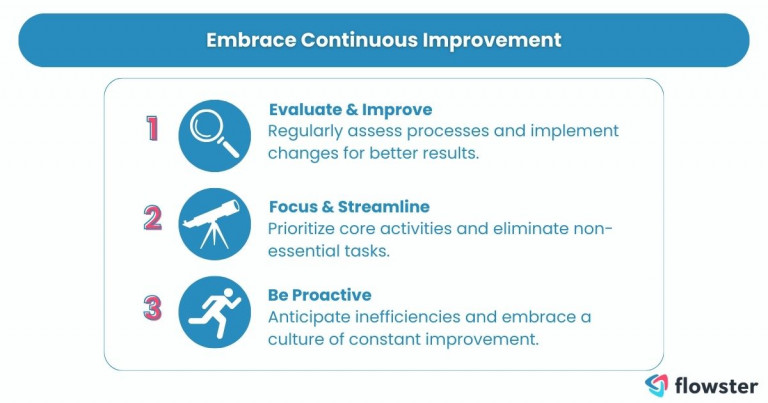
Monitoring and Measuring Process Efficiency
Monitoring and measuring process efficiency is like taking the pulse of your business. It provides a snapshot of your business’s health and helps you identify areas that need improvement. Continuous monitoring and optimization are essential for observing improvements and ensuring processes are efficient and sustainable over time.
Process monitoring is a central element in the Business Process Management Life Cycle (PMLC), particularly important for the continuous improvement of processes during the Feedback & Controlling phase. As an organization’s BPM maturity level increases, process monitoring becomes more effective due to the use of advanced tools and techniques that provide deeper insights into the entire process.
Critical metrics and Key Performance Indicators (KPIs) are fundamental to business process monitoring. They allow for data-driven decisions and process optimization. By tracking these metrics and KPIs, you can gain valuable insights into your process efficiency and identify areas that need improvement.

Key Metrics and KPIs
Key Performance Indicators (KPIs) are like the compass guiding your journey to process efficiency. They provide a clear direction and help you stay on the right path. Implementing KPIs accurately tailored to the process being measured is crucial for identifying inefficiencies.
In addition to KPIs, various metrics, such as:
- resource efficiency
- capacity
- labor productivity
- throughput
- turnaround time
- profitability
- quality
- return on investment
are used to assess process efficiency. By defining and tracking these metrics in alignment with your organization’s strategic objectives, you can prioritize process improvements and monitor stages of the process for consistent performance.
Utilizing Data Analytics
Data analytics is like the magnifying glass that helps you examine your process efficiency in detail. It transforms real-time data into actionable insights, enabling you to:
- Monitor and measure your process efficiency effectively
- Identify bottlenecks and areas for improvement
- Make data-driven decisions
- Optimize resource allocation
- Improve customer satisfaction
Business Intelligence (BI) platforms, process mining software, or custom solutions can be instrumental in this regard.
An effective data analytics approach for process improvement is structured around the following steps:
- Setting clear objectives
- Collecting and organizing data
- Deriving insights
- Continuously implementing and monitoring enhancements
Dynamic dashboards offer real-time monitoring and display critical KPIs and trends, aiding stakeholders in making informed decisions for process optimization.
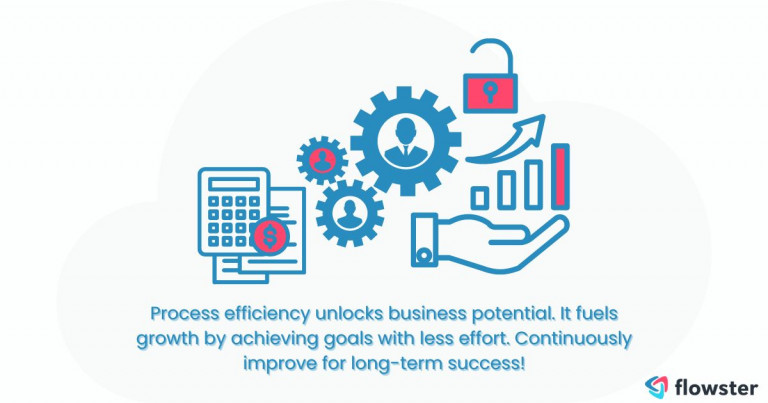
Summary
In a nutshell, process efficiency is the key to unlocking the full potential of your business. It’s the catalyst that drives your business growth, enabling you to achieve your business objectives with minimal effort. From understanding what process efficiency is and the factors affecting it to identifying inefficiencies and implementing strategies to improve it, every aspect is crucial in your quest for process efficiency.
So, whether you’re just starting out on your journey to process efficiency or you’re looking to level up, remember that it’s a continuous process. There are always areas that can be improved, processes that can be streamlined, and efficiencies that can be gained. So, keep striving for improvement, keep your finger on the pulse of your business, and watch your business thrive.
Frequently Asked Questions
What techniques are used to improve process efficiency?
To improve process efficiency, you can streamline workflows by reducing redundancies, automate tasks, integrate advanced analytics and machine learning, and implement real-time tracking systems to monitor and improve Key Performance Indicators (KPIs). This will help you achieve a more efficient operation.
How can we improve the process?
To improve the process, you can follow these steps: choose a specific process to review, break down the process steps into tasks, connect tasks to simulate the process flow, arrange them in swim lanes to show responsibility, find bottlenecks, implement training, practice continuous improvement, and lean on process automation. This can help streamline and optimize the process.
What is process efficiency?
Process efficiency is the amount of work or effort needed to achieve a business goal, with a higher percentage indicating more value added to your operations.
How can I monitor and measure process efficiency?
To monitor and measure process efficiency, continually optimize your processes, tailor key performance indicators (KPIs) accurately, and use data analytics to gain insights. This will help you track and improve efficiency in your operations.
What are the benefits of efficient processes?
Efficient processes bring cost savings, reduced errors, higher customer satisfaction, improved productivity, and more. They also create a more positive work environment and boost staff morale.
Need an Easy Way to Document Processes?
Flowster makes it simple to create standard operating procedures using artificial intelligence, or you can browse our pre-built SOP templates in the Flowster Marketplace. These templates are designed to meet a variety of business needs and can be easily customized to meet your specific requirements.
Do you require assistance? Use our “Done for You” services to have our quality and improvement experts design custom workflows for you. Our team can help you create SOPs from scratch, ensuring that they are fully aligned with your business processes and goals.




